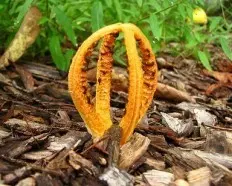Lattice columnar (Clathrus columnatus)
- Division: Basidiomycota (Basidiomycetes)
- Subdivision: Agaricomycotina (Agaricomycetes)
- Class: Agaricomycetes (Agaricomycetes)
- Subclass: Phallomycetidae (Velkovye)
- Order: Phallales (Merry)
- Family: Phallaceae (Veselkovye)
- Genus: Clathrus (Clatrus)
- Type: Clathrus columnatus (Columnar Lattice)
:
- Laterane colonnade
- linderia colonnade
- colonnaria colonnade
- Linderiella colonnade
- Clathrus colonnarius
- Clathrus brasiliensis
- Clathrus trilobatus

Like other Veselkovye, Clathrus columnatus is born from an “egg”.
At the egg stage the fruit body is partially immersed in the substrate, it is round, almost spherical in shape, may be slightly flattened from below, 3×5 centimeters, with longitudinal furrows corresponding to the insertion of the peridial sutures and, consequently, to the lobes of the receptacle.
If you make a vertical cut, a rather thin peridium will be visible, very thin at the top, thicker at the base, followed by a gelatinous layer up to 8 mm thick, and inside – a rounded gleba with a diameter of about 1,7 cm, occupying the upper part of the central part of the egg.
The outer shell of the peridium is more often white, less often creamy, creamy to pale brown, sometimes cracking, forming angular brown scales. Quite strong strands of mycelium go from the egg to the substrate, which, if desired, can be excavated and traced to the roots, stumps and other woody materials immersed in the substrate.
When the egg shell breaks, a fruiting fruiting body unfolds from it in the form of separate lobes, fused at the top. They resemble graceful curved columns or brackets. There can be from 2 to 6 such blades. The inner surface of the blades is covered with spore-containing mucus with a specific odor that attracts flies. Flies are the main spreaders of spores in fungi of the entire family of fungi.
The height of the blades is 5-15 centimeters. Color pinkish to reddish or orange, pale below, brighter above. The thickness of each blade is up to 2 centimeters in the widest part.
In some cases, two adjacent lobes may be connected by a transverse bridge, especially near the top of the structure, or sometimes there may be an incomplete transverse process attached to only one vane.
Cutaway each blade is an ellipse with a longitudinal groove on the outside and a rather complex system of grooves and grooves inside.
Legs or the blades do not have any common base, they come out directly from the burst egg, which remains in the form of a volva.
spore-containing mucus (precisely “mucus”, since the oars do not have spore powder in the form of a “powder”) an abundant, initially compact mass, attached to the upper part where the lobes are connected, and slowly sliding down, at first olive green, gradually becoming olive brown , dark.
Споры cylindrical with rounded ends, 3-4 x 1,5-2 microns.
Like all Phallaceae species, C. columnatus is a saprophyte and uses extracellular digestion to obtain nutrients from dead and decaying organic matter such as wood. Due to its propensity for dead wood, the fungus is often associated with disturbed habitats. Often found growing in and around gardens, parks, clearings, where human activity has resulted in accumulations of mulch, wood chips, or other cellulose-rich materials.
Spring – autumn.
The fungus has been found in Australia, New Zealand, Oceania, New Guinea, Africa, as well as in North and South America, Hawaii, and China. It is believed to have been introduced to North America as it usually appears in landscaped areas or other areas where exotic plants have been planted.
Unknown.

Javan flowertail (Pseudocolus fusiformis)
considered to be the most similar. It has 3-4 lobes growing from a common stem (which can be very short and hidden in the volva). Its “eggs” – and thus the Volvo – are usually greyish to greyish brown (not white or creamy).
The best and easiest way to tell the Columnar Lattice from the Javan Flowertail is to cut open the Volvo and pull the whole structure out of it. If there is a common stem, it is a flower tail. If the “columns” are not connected to each other in any way, there is no common foundation – this is a columnar Lattice. We are talking about mushrooms in their adult state, of course. Accurate identification of veselkovye at the “egg” stage is often impossible.
Photo: Veronika.









